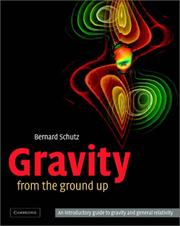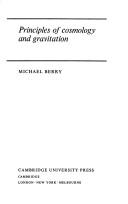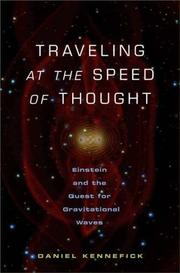| Listing 1 - 6 of 6 |
Sort by
|

ISBN: 110715717X 1139635875 9786612389443 1282389440 0511644698 0511807805 0511648693 0511336314 0511555512 0511336969 9780511648694 9780511336966 9780511251900 0511251904 9780511807800 9781282389441 0521455065 9780521455060 9781139635875 6612389443 9780511644696 9780511336317 9780511555510 Year: 2003 Publisher: Cambridge : Cambridge university press,
Abstract | Keywords | Export | Availability | Bookmark
 Loading...
Loading...Choose an application
- Reference Manager
- EndNote
- RefWorks (Direct export to RefWorks)
This book invites the reader to understand our Universe, not just marvel at it. From the clock-like motions of the planets to the catastrophic collapse of a star into a black hole, gravity controls the Universe. Gravity is central to modern physics, helping to answer the deepest questions about the nature of time, the origin of the Universe and the unification of the forces of nature. Linking key experiments and observations through careful physical reasoning, the author builds the reader's insight step-by-step from simple but profound facts about gravity on Earth to the frontiers of research. Topics covered include the nature of stars and galaxies, the mysteries of dark matter and dark energy, black holes, gravitational waves, inflation and the Big Bang. Suitable for general readers and for undergraduate courses, the treatment uses only high-school level mathematics, supplemented by optional computer programs, to explain the laws of physics governing gravity.
Gravitation. --- Gravity. --- Geophysics --- Mechanics --- Pendulum --- Field theory (Physics) --- Matter --- Physics --- Antigravity --- Centrifugal force --- Relativity (Physics) --- Properties --- Gravitation --- Gravity --- 531.5 --- 531.5 Gravity. Gravitation. Pendulums. Ballistics --- Gravity. Gravitation. Pendulums. Ballistics
Book
ISBN: 9073035090 Year: 1991 Publisher: Maastricht : Natuur en Techniek,
Abstract | Keywords | Export | Availability | Bookmark
 Loading...
Loading...Choose an application
- Reference Manager
- EndNote
- RefWorks (Direct export to RefWorks)
Theory of relativity. Unified field theory --- Geophysics --- 531.5 --- 530.12 --- #WSCH:AAS2 --- fysica --- zwaartekracht --- 531 --- getijden --- massa --- mechanica --- ruimte --- ruimtemeetkunde --- tijd --- wiskunde --- zwarte gaten --- Zwaartekracht --- Gravity. Gravitation. Pendulums. Ballistics --- Relativity principle --- Gravitatie --- Kosmologie --- relativiteitstheorie --- Kosmologie. --- relativiteitstheorie. --- 530.12 Relativity principle --- 531.5 Gravity. Gravitation. Pendulums. Ballistics
Book
ISBN: 9780521882231 0521882230 9780511807787 9780511673559 0511673558 0511675534 9780511675539 1139637665 9781139637664 1107211166 9781107211162 1282486780 9781282486782 9786612486784 6612486783 0511807783 0511674341 9780511674341 0511672284 9780511672286 0511671008 9780511671005 Year: 2010 Publisher: Cambridge, UK: Cambridge university press,
Abstract | Keywords | Export | Availability | Bookmark
 Loading...
Loading...Choose an application
- Reference Manager
- EndNote
- RefWorks (Direct export to RefWorks)
Covering all aspects of gravitation in a contemporary style, this advanced textbook is ideal for graduate students and researchers in all areas of theoretical physics. The 'Foundation' section develops the formalism in six chapters, and uses it in the next four chapters to discuss four key applications - spherical spacetimes, black holes, gravitational waves and cosmology. The six chapters in the 'Frontier' section describe cosmological perturbation theory, quantum fields in curved spacetime, and the Hamiltonian structure of general relativity, among several other advanced topics, some of which are covered in-depth for the first time in a textbook. The modular structure of the book allows different sections to be combined to suit a variety of courses. Over 200 exercises are included to test and develop the reader's understanding. There are also over 30 projects, which help readers make the transition from the book to their own original research.
Gravitation --- Relativity (Physics) --- 531.5 --- Gravity. Gravitation. Pendulums. Ballistics --- 531.5 Gravity. Gravitation. Pendulums. Ballistics --- Nonrelativistic quantum mechanics --- Space and time --- Field theory (Physics) --- Matter --- Physics --- Antigravity --- Centrifugal force --- Properties --- Gravitation. --- Textbooks. --- Gravitation - Textbooks --- Relativity (Physics) - Textbooks --- Gravitation - Problems, exercises, etc.

ISBN: 0521210615 0521290287 9780521210614 9780521290289 Year: 1976 Publisher: Cambridge: Cambridge university press,
Abstract | Keywords | Export | Availability | Bookmark
 Loading...
Loading...Choose an application
- Reference Manager
- EndNote
- RefWorks (Direct export to RefWorks)
Theory of relativity. Unified field theory --- Cosmology --- Gravitation --- 521 --- 524.8 --- 530.12 --- 531.5 --- Field theory (Physics) --- Matter --- Physics --- Antigravity --- Centrifugal force --- Relativity (Physics) --- Astronomy --- Deism --- Metaphysics --- 524.8 The Universe. Metagalaxy. Cosmology --- The Universe. Metagalaxy. Cosmology --- 531.5 Gravity. Gravitation. Pendulums. Ballistics --- Gravity. Gravitation. Pendulums. Ballistics --- 530.12 Relativity principle --- Relativity principle --- 521 Theoretical astronomy. Celestial mechanics --- Theoretical astronomy. Celestial mechanics --- Properties --- Cosmology. --- Gravitation.

ISBN: 1400882745 9781400882748 0691117276 9780691117270 Year: 2007 Publisher: Princeton, N.J.
Abstract | Keywords | Export | Availability | Bookmark
 Loading...
Loading...Choose an application
- Reference Manager
- EndNote
- RefWorks (Direct export to RefWorks)
Since Einstein first described them nearly a century ago, gravitational waves have been the subject of more sustained controversy than perhaps any other phenomenon in physics. These as yet undetected fluctuations in the shape of space-time were first predicted by Einstein's general theory of relativity, but only now, at the dawn of the twenty-first century, are we on the brink of finally observing them. Daniel Kennefick's landmark book takes readers through the theoretical controversies and thorny debates that raged around the subject of gravitational waves after the publication of Einstein's theory. The previously untold story of how we arrived at a settled theory of gravitational waves includes a stellar cast from the front ranks of twentieth-century physics, including Richard Feynman, Hermann Bondi, John Wheeler, Kip Thorne, and Einstein himself, who on two occasions avowed that gravitational waves do not exist, changing his mind both times. The book derives its title from a famously skeptical comment made by Arthur Stanley Eddington in 1922--namely, that "gravitational waves propagate at the speed of thought." Kennefick uses the title metaphorically to contrast the individual brilliance of each of the physicists grappling with gravitational-wave theory against the frustratingly slow progression of the field as a whole. Accessibly written and impeccably researched, this book sheds new light on the trials and conflicts that have led to the extraordinary position in which we find ourselves today--poised to bring the story of gravitational waves full circle by directly confirming their existence for the very first time.
Space and time. --- General relativity (Physics) --- Einstein field equations. --- Gravitational waves. --- Space of more than three dimensions --- Space-time --- Space-time continuum --- Space-times --- Spacetime --- Time and space --- Fourth dimension --- Infinite --- Metaphysics --- Philosophy --- Space sciences --- Time --- Beginning --- Hyperspace --- Relativity (Physics) --- Relativistic theory of gravitation --- Relativity theory, General --- Gravitation --- Physics --- Einstein's field equations --- Einstein's gravitational field equations --- Einstein's law of gravitation --- Field equations, Einstein --- Differential equations --- Field theory (Physics) --- Gravitational fields --- Gravitational radiation --- Gravity waves (Astrophysics) --- Radiation --- Waves --- Einstein field equations --- Gravitational waves --- Space and time --- 531.5 --- 531.5 Gravity. Gravitation. Pendulums. Ballistics --- Gravity. Gravitation. Pendulums. Ballistics
Book
ISBN: 0521382580 052138897X 9780521388979 9780521382588 Year: 1990 Publisher: Cambridge : Cambridge university press,
Abstract | Keywords | Export | Availability | Bookmark
 Loading...
Loading...Choose an application
- Reference Manager
- EndNote
- RefWorks (Direct export to RefWorks)
Chaotic behavior in systems --- Pendulum --- Chaos --- Pendule --- Chaotic behavior in systems. --- Pendulum. --- #TELE:SISTA --- #WPLT:dd.Prof.F.Symons --- 517.988 --- 517.988 Nonlinear functional analysis and approximation methods --- Nonlinear functional analysis and approximation methods --- Mechanics --- Rotational motion (Rigid dynamics) --- Gravity --- Chaos in systems --- Chaos theory --- Chaotic motion in systems --- Differentiable dynamical systems --- Dynamics --- Nonlinear theories --- System theory --- dynamica --- Differential geometry. Global analysis --- chaos --- Mathematical physics --- Classical mechanics. Field theory --- Physics --- Pendulums
| Listing 1 - 6 of 6 |
Sort by
|

 Search
Search Feedback
Feedback About UniCat
About UniCat  Help
Help News
News